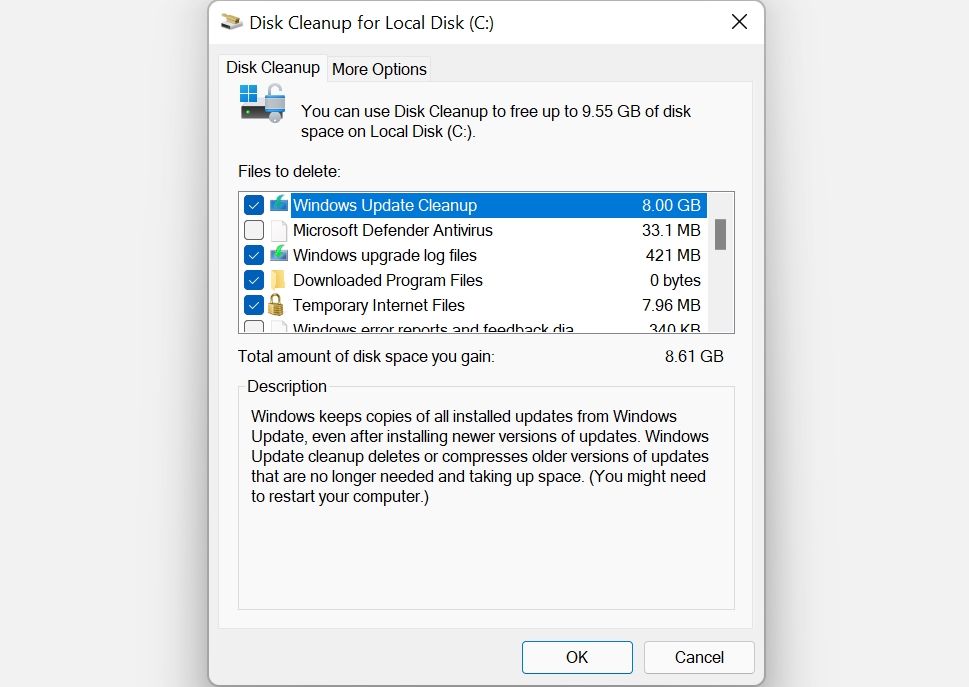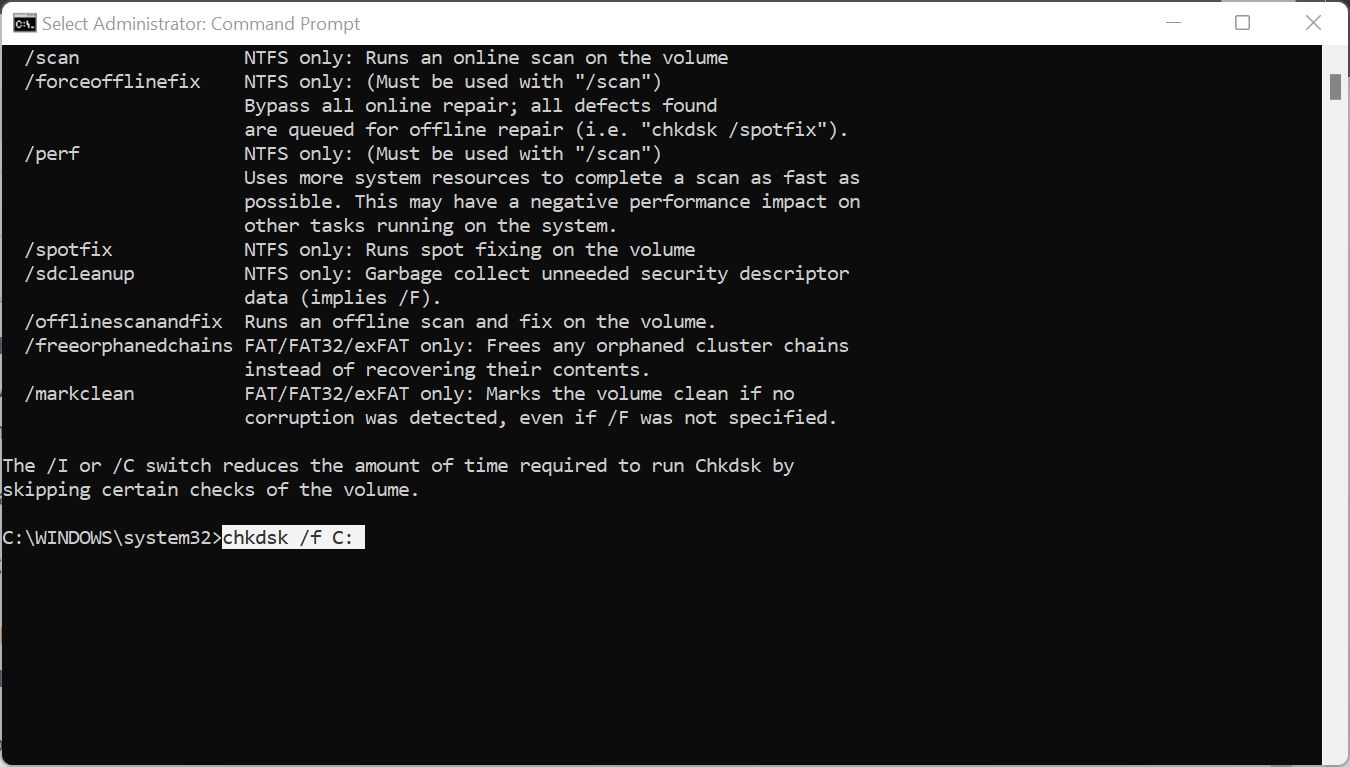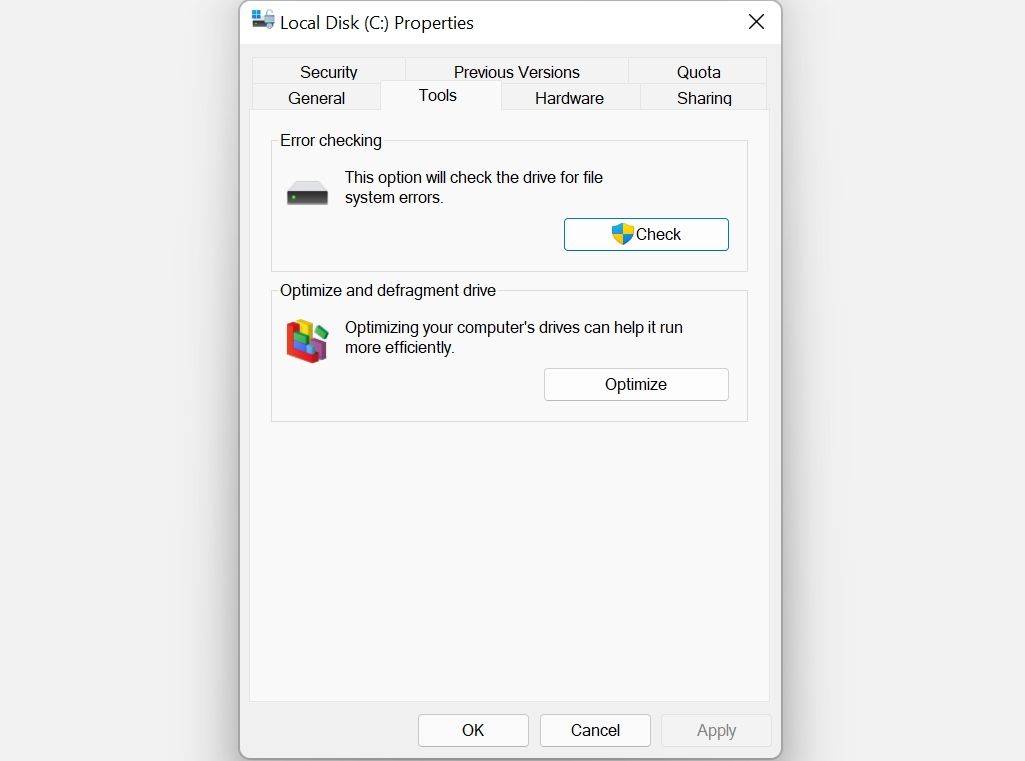 System Tutorial
System Tutorial
 Windows Series
Windows Series
 6 Fixes if the C: Drive Keeps Filling Up for No Reason on Windows
6 Fixes if the C: Drive Keeps Filling Up for No Reason on Windows
6 Fixes if the C: Drive Keeps Filling Up for No Reason on Windows
The C: drive in a Windows 11 or 10 PC contains the Windows installation files, along with other important files and folders, that all take up space. But if you notice the C: drive on your Windows computer fills up repeatedly, it may be a deeper issue that you should fix.
Start With These Quick Maintenance Tips
The C: drive might keep filling up because you store everything there instead of partitioning your physical drive. Try relocating personal folders to another partition or an external drive to free up some space. Additionally, change the default save location for files and folders so that new downloads are automatically saved elsewhere.
Also, check your installed apps and remove anything unnecessary. Even if you didn’t recently install any new apps, your system might contain bloatware or unnecessary software you can remove.
If you need more solutions to free up the C: drive, follow the tips below.
1. Scan for Malware
Viruses and other malware are some of the most common perpetrators behind unusual storage use on your hard drive. Thus, the first step you should take after noticing a C: drive storage issue is scanning for infection.
Windows Defender does the job well and provides adequate protection against all types of PC malware. While it has real-time protection, you should perform a full system scan to detect any hidden malware on your computer:
- In the Start menu search bar or Windows Search, type Windows Security.
- Click on the Windows Security app from the results. You'll recognize its shield icon.
- On the next screen, click on Virus & threat protection.
- Under Current Threats, click Scan options.
- On the next screen, ensure that the Full Scan option is selected.
- Click on Scan now.
- Wait for Windows to finish scanning the computer for viruses.

While the scan is in progress, you may notice a slowdown in your computer. It's recommended you postpone any resource-intensive tasks until the scan is over. If you use third-party antivirus software, you can perform a full scan by opening the application's dashboard (usually in the System Tray) and proceeding from there. The exact method differs across different antivirus vendors.
If this ends up being the source of your problem, see the steps you should take upon discovering malware on your computer.
2. Run Disk Cleanup
Temporary files, such as thumbnails and previous Windows updates, take up a lot of space on your hard drive. The Disk Cleanup utility in Windows can help you safely delete temporary files, old copies of Windows Update files, Windows upgrade logs, and more:
- Type Disk Cleanup in the Start menu search bar or Windows Search.
- Right-click on Disk Cleanup > Run as administrator from the search results.
- Select Local Disk (C:) from the disk selection menu and click OK.
- Under Files to delete, check options such as temporary internet files, thumbnails, and previous Windows installations and updates. Note that you won't be able to roll back Windows updates if you check the Windows Update Cleanup option.
- Click OK.
- On the next prompt, click Delete files.
- Wait for Disk Cleanup to do its job.

Disk Cleanup is also recommended to manage the massive WinSxs (Windows Side-by-Side) system folder. This Windows component stocks different versions of DLL, EXE, and OCX files. It plays a vital role as it helps update Windows without overwriting or deleting critical files, and in case of a crash, it can help roll back changes. However, WinSxs can balloon up to a size of 5-10GB.
Windows automatically manages the WinSxs folder, but it may be easier to run the Disk Cleanup tool to reduce its size.
3. Use CHKDSK to Find File System Errors
Logical errors on your storage disk can cause all sorts of malfunctions. This includes the incorrect reading of free disk space and storage allocation issues. You can perform a CHKDSK scan using Windows Command Prompt or the Local Disk properties menu to fix this.
How to Run CHKDSK Using Command Prompt
CHKDSK is a Windows utility that scans and fixes logical errors on your SSD or hard drive. To use it:
- Type cmd in Windows search.
- Right-click on Command Prompt > Run as administrator.
- In the CMD console, enter chkdsk C: /f and press Enter.
- CHKDSK will scan the C: drive for errors and automatically fix them upon detection.
- Restart your computer after the scan is complete.

How to Run CHKDSK Using Drive Properties
If you prefer to use CHKDSK without the command line, use this method:
- Open File Explorer using the Win + E shortcut.
- Navigate to This PC.
- Right-click on Local Disk (C:).
- Click on Properties.
- Choose the Tools tab.
- Under Error Checking, click Check. You will need administrative privileges to go through with the scan.
- Click on the Scan Drive option when prompted.

4. Manage Your System Restore Points
System Restore is a critical Windows feature that allows you to restore your computer to a previous state in case of problems. But System Restore Points can take up a lot of space on your PC, depending upon how you've configured the function.
To adjust the space that System Restore points take up, follow these steps:
- Type System Restore in the Start menu search bar and click Create a restore point.
- Under Protection Settings, select Local Disk (C:) in the Available Drives box, then hit Configure.
- In the next window, move the Max Usage slider to the left. The further left, the less space System Restore will use to make restore points.
- Click OK > OK once you're satisfied.

Alternatively, you can delete unneeded System Restore points to free up additional space on your computer.
5. Extend the C: Partition
If you're sure that the storage issue on your computer is not the result of anything above, it may be worth extending the storage space on the C: partition. Of course, this is only possible if you have multiple partitions on your drive, or unallocated space is available.
All these operations can be performed using Disk Management:
- Press Win + R to open the Run box. Type diskmgmt.msc and press Enter.
- In the Disk Management window, right-click on Local Disk (C:).
- Click on the Extend Volume option.
- If it's grayed out, no unallocated space is available on your storage device. To unallocate space from another partition, right-click the partition and select Shrink Volume. Then enter the amount of space you want to reallocate.
- In the Extend Volume Wizard, click Next.
- Adjust the amount of space you want to add to the C: drive using the Select the amount of space in MB option.
- Click Next > Finish.

6. Stop Your Computer From Hibernating
When your computer enters hibernation mode, it saves energy by shutting your system off completely, while enabling you to pick up your work from where you left off. While this may be convenient, hibernation files can fill up your C: drive.
To turn off hibernation, launch Command Prompt with administrative rights (right-click the Start button for a shortcut) and run this command:
<code class="hljs ">powercfg.exe /hibernate off</code>
As your computer will no longer hibernate, be sure to save all your work before leaving your desk.
If you need more help keeping the C: drive clutter-free, you can use a third-party app to clean your disk. Besides freeing up space on your C: drive, these tools could improve your computer’s overall performance.
The above is the detailed content of 6 Fixes if the C: Drive Keeps Filling Up for No Reason on Windows. For more information, please follow other related articles on the PHP Chinese website!

Hot AI Tools

Undresser.AI Undress
AI-powered app for creating realistic nude photos

AI Clothes Remover
Online AI tool for removing clothes from photos.

Undress AI Tool
Undress images for free

Clothoff.io
AI clothes remover

Video Face Swap
Swap faces in any video effortlessly with our completely free AI face swap tool!

Hot Article

Hot Tools

Notepad++7.3.1
Easy-to-use and free code editor

SublimeText3 Chinese version
Chinese version, very easy to use

Zend Studio 13.0.1
Powerful PHP integrated development environment

Dreamweaver CS6
Visual web development tools

SublimeText3 Mac version
God-level code editing software (SublimeText3)

Hot Topics
 1664
1664
 14
14
 1423
1423
 52
52
 1318
1318
 25
25
 1269
1269
 29
29
 1248
1248
 24
24
 Windows kb5054979 update information Update content list
Apr 15, 2025 pm 05:36 PM
Windows kb5054979 update information Update content list
Apr 15, 2025 pm 05:36 PM
KB5054979 is a cumulative security update released on March 27, 2025, for Windows 11 version 24H2. It targets .NET Framework versions 3.5 and 4.8.1, enhancing security and overall stability. Notably, the update addresses an issue with file and directory operations on UNC shares using System.IO APIs. Two installation methods are provided: one through Windows Settings by checking for updates under Windows Update, and the other via a manual download from the Microsoft Update Catalog.
 Nanoleaf Wants to Change How You Charge Your Tech
Apr 17, 2025 am 01:03 AM
Nanoleaf Wants to Change How You Charge Your Tech
Apr 17, 2025 am 01:03 AM
Nanoleaf's Pegboard Desk Dock: A Stylish and Functional Desk Organizer Tired of the same old charging setup? Nanoleaf's new Pegboard Desk Dock offers a stylish and functional alternative. This multifunctional desk accessory boasts 32 full-color RGB
 Got an AMD CPU and Aren't Using PBO? You're Missing Out
Apr 12, 2025 pm 09:02 PM
Got an AMD CPU and Aren't Using PBO? You're Missing Out
Apr 12, 2025 pm 09:02 PM
Unlocking Ryzen's Potential: A Simple Guide to Precision Boost Overdrive (PBO) Overclocking your new PC can seem daunting. While performance gains might feel elusive, leaving potential untapped is even less appealing. Fortunately, AMD Ryzen processo
 ASUS' ROG Zephyrus G14 OLED Gaming Laptop Is $300 Off
Apr 16, 2025 am 03:01 AM
ASUS' ROG Zephyrus G14 OLED Gaming Laptop Is $300 Off
Apr 16, 2025 am 03:01 AM
ASUS ROG Zephyrus G14 Esports Laptop Special Offer! Buy ASUS ROG Zephyrus G14 Esports Laptop now and enjoy a $300 offer! Original price is $1999, current price is only $1699! Enjoy immersive gaming experience anytime, anywhere, or use it as a reliable portable workstation. Best Buy currently offers offers on this 2024 14-inch ASUS ROG Zephyrus G14 e-sports laptop. Its powerful configuration and performance are impressive. This ASUS ROG Zephyrus G14 e-sports laptop costs 16 on Best Buy
 How to Use Windows 11 as a Bluetooth Audio Receiver
Apr 15, 2025 am 03:01 AM
How to Use Windows 11 as a Bluetooth Audio Receiver
Apr 15, 2025 am 03:01 AM
Turn your Windows 11 PC into a Bluetooth speaker and enjoy your favorite music from your phone! This guide shows you how to easily connect your iPhone or Android device to your computer for audio playback. Step 1: Pair Your Bluetooth Device First, pa
 5 Hidden Windows Features You Should Be Using
Apr 16, 2025 am 12:57 AM
5 Hidden Windows Features You Should Be Using
Apr 16, 2025 am 12:57 AM
Unlock Hidden Windows Features for a Smoother Experience! Discover surprisingly useful Windows functionalities that can significantly enhance your computing experience. Even seasoned Windows users might find some new tricks here. Dynamic Lock: Auto
 5 Windows Settings to Change to Improve Laptop Battery Life
Apr 12, 2025 am 06:04 AM
5 Windows Settings to Change to Improve Laptop Battery Life
Apr 12, 2025 am 06:04 AM
Is your Windows laptop battery draining faster than you'd like? Don't worry, you can significantly extend its life with a few simple tweaks to Windows' built-in power management features. Here's how to maximize your laptop's battery life on a singl
 How to Customize Your Windows 11 Notifications
Apr 14, 2025 am 04:05 AM
How to Customize Your Windows 11 Notifications
Apr 14, 2025 am 04:05 AM
Detailed explanation of Windows 11 notification settings: Create a personalized notification experience Windows 11 integrates the Notification Center into the calendar, and although it takes some time to adapt, the frequency of notifications has not changed. If you are tired of the constantly popping up system updates and useless application notifications, this article will guide you to customize Windows 11 notifications and optimize your workflow. Global notification settings Almost all notification-related options are located in Settings in Windows 11. Step 1: Click the "Start" menu and select "Settings" (or press "Windows I"). Step 2: Select System in the left sidebar. Step 3: Click "Notification" to access all notification options.



